Latch INFINITI Q50 2018 Owner's Manual
[x] Cancel search | Manufacturer: INFINITI, Model Year: 2018, Model line: Q50, Model: INFINITI Q50 2018Pages: 458, PDF Size: 2.13 MB
Page 9 of 458
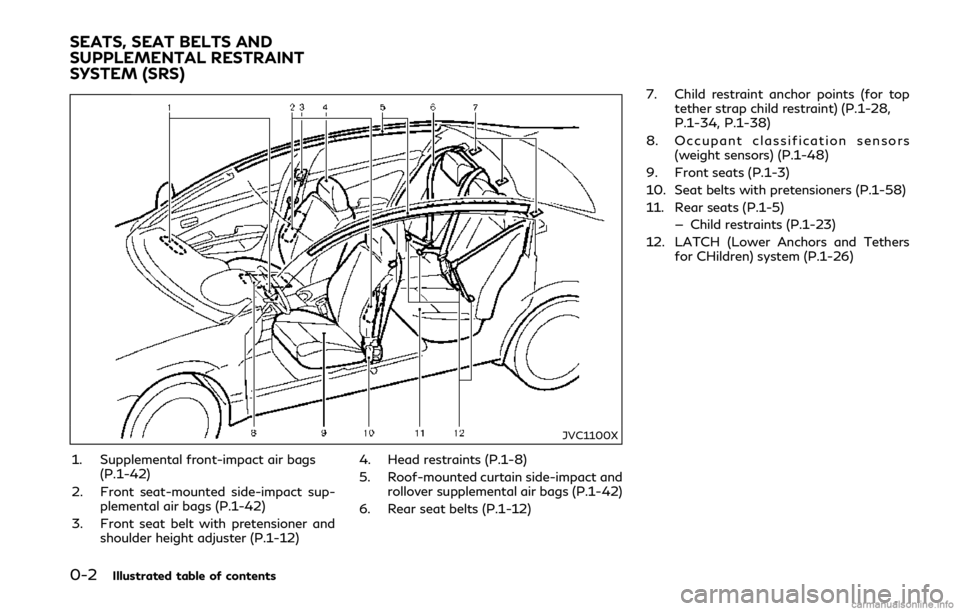
0-2Illustrated table of contents
JVC1100X
1. Supplemental front-impact air bags(P.1-42)
2. Front seat-mounted side-impact sup- plemental air bags (P.1-42)
3. Front seat belt with pretensioner and shoulder height adjuster (P.1-12) 4. Head restraints (P.1-8)
5. Roof-mounted curtain side-impact and
rollover supplemental air bags (P.1-42)
6. Rear seat belts (P.1-12) 7. Child restraint anchor points (for top
tether strap child restraint) (P.1-28,
P.1-34, P.1-38)
8. Occupant classification sensors (weight sensors) (P.1-48)
9. Front seats (P.1-3)
10. Seat belts with pretensioners (P.1-58)
11. Rear seats (P.1-5) — Child restraints (P.1-23)
12. LATCH (Lower Anchors and Tethers for CHildren) system (P.1-26)
SEATS, SEAT BELTS AND
SUPPLEMENTAL RESTRAINT
SYSTEM (SRS)
Page 20 of 458
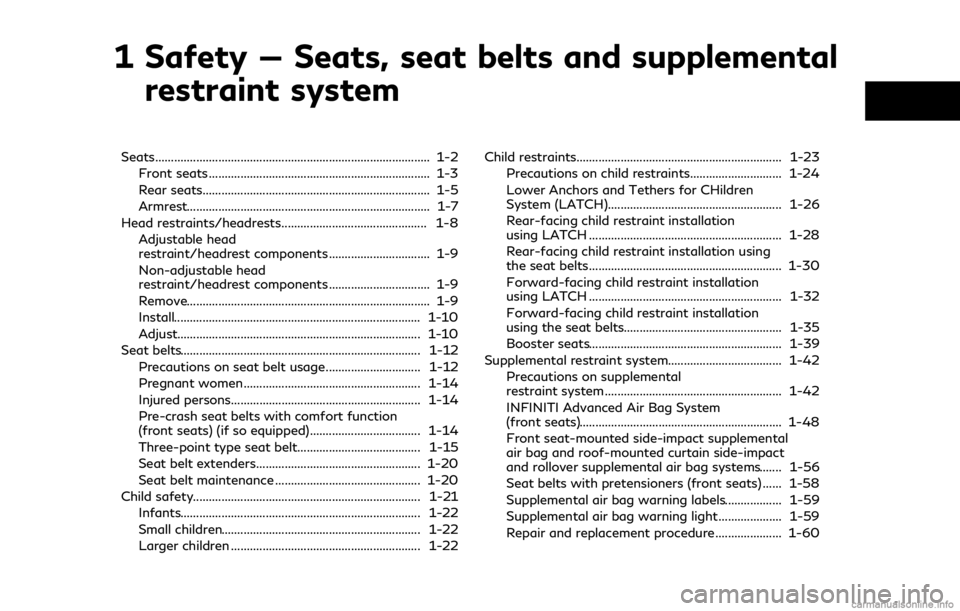
1 Safety — Seats, seat belts and supplementalrestraint system
Seats........................................................................\
............... 1-2
Front seats ...................................................................... 1-3
Rear seats........................................................................\
1-5
Armrest........................................................................\
..... 1-7
Head restraints/headrests.............................................. 1-8 Adjustable head
restraint/headrest components ................................ 1-9
Non-adjustable head
restraint/headrest components ................................ 1-9
Remove........................................................................\
..... 1-9
Install........................................................................\
...... 1-10
Adjust........................................................................\
..... 1-10
Seat belts........................................................................\
.... 1-12
Precautions on seat belt usage.............................. 1-12
Pregnant women........................................................ 1-14
Injured persons............................................................ 1-14
Pre-crash seat belts with comfort function
(front seats) (if so equipped)................................... 1-14
Three-point type seat belt....................................... 1-15
Seat belt extenders.................................................... 1-20
Seat belt maintenance .............................................. 1-20
Child safety........................................................................\
1-21 Infants........................................................................\
.... 1-22
Small children............................................................... 1-22
Larger children ............................................................ 1-22 Child restraints................................................................. 1-23
Precautions on child restraints............................. 1-24
Lower Anchors and Tethers for CHildren
System (LATCH)....................................................... 1-26
Rear-facing child restraint installation
using LATCH ............................................................. 1-28
Rear-facing child restraint installation using
the seat belts............................................................. 1-30
Forward-facing child restraint installation
using LATCH ............................................................. 1-32
Forward-facing child restraint installation
using the seat belts.................................................. 1-35
Booster seats............................................................. 1-39
Supplemental restraint system.................................... 1-42 Precautions on supplemental
restraint system ........................................................ 1-42
INFINITI Advanced Air Bag System
(front seats)................................................................ 1-48
Front seat-mounted side-impact supplemental
air bag and roof-mounted curtain side-impact
and rollover supplemental air bag systems....... 1-56
Seat belts with pretensioners (front seats) ...... 1-58
Supplemental air bag warning labels.................. 1-59
Supplemental air bag warning light .................... 1-59
Repair and replacement procedure..................... 1-60
Page 24 of 458
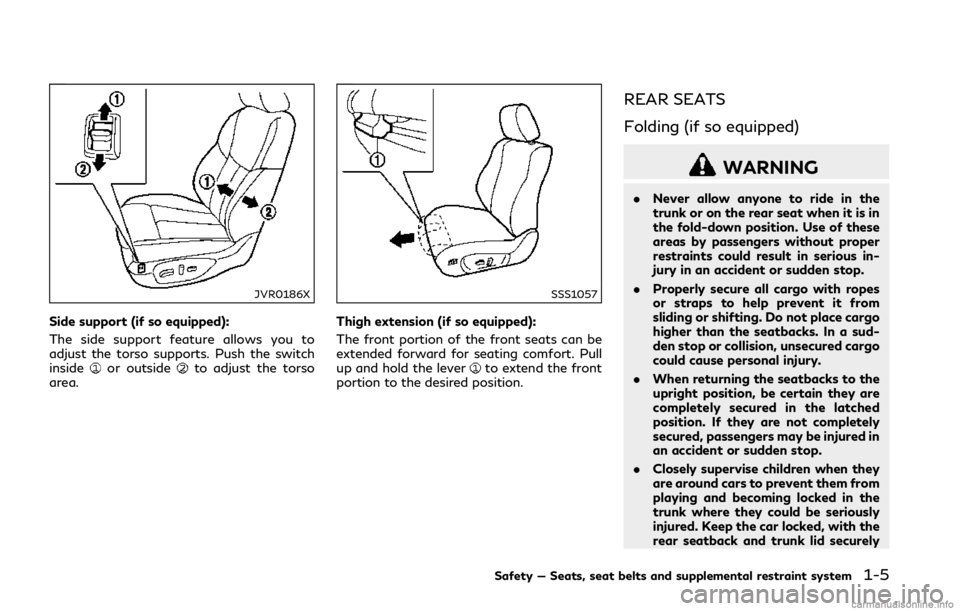
JVR0186X
Side support (if so equipped):
The side support feature allows you to
adjust the torso supports. Push the switch
inside
or outsideto adjust the torso
area.
SSS1057
Thigh extension (if so equipped):
The front portion of the front seats can be
extended forward for seating comfort. Pull
up and hold the lever
to extend the front
portion to the desired position.
REAR SEATS
Folding (if so equipped)
WARNING
. Never allow anyone to ride in the
trunk or on the rear seat when it is in
the fold-down position. Use of these
areas by passengers without proper
restraints could result in serious in-
jury in an accident or sudden stop.
. Properly secure all cargo with ropes
or straps to help prevent it from
sliding or shifting. Do not place cargo
higher than the seatbacks. In a sud-
den stop or collision, unsecured cargo
could cause personal injury.
. When returning the seatbacks to the
upright position, be certain they are
completely secured in the latched
position. If they are not completely
secured, passengers may be injured in
an accident or sudden stop.
. Closely supervise children when they
are around cars to prevent them from
playing and becoming locked in the
trunk where they could be seriously
injured. Keep the car locked, with the
rear seatback and trunk lid securely
Safety — Seats, seat belts and supplemental restraint system1-5
Page 25 of 458
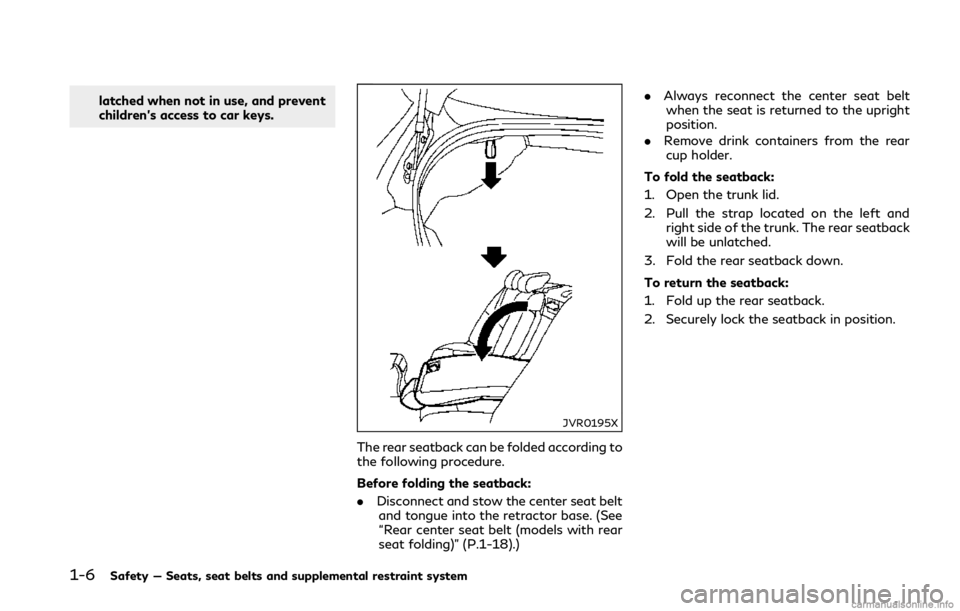
1-6Safety — Seats, seat belts and supplemental restraint system
latched when not in use, and prevent
children’s access to car keys.
JVR0195X
The rear seatback can be folded according to
the following procedure.
Before folding the seatback:
.Disconnect and stow the center seat belt
and tongue into the retractor base. (See
“Rear center seat belt (models with rear
seat folding)” (P.1-18).) .
Always reconnect the center seat belt
when the seat is returned to the upright
position.
. Remove drink containers from the rear
cup holder.
To fold the seatback:
1. Open the trunk lid.
2. Pull the strap located on the left and right side of the trunk. The rear seatback
will be unlatched.
3. Fold the rear seatback down.
To return the seatback:
1. Fold up the rear seatback.
2. Securely lock the seatback in position.
Page 35 of 458
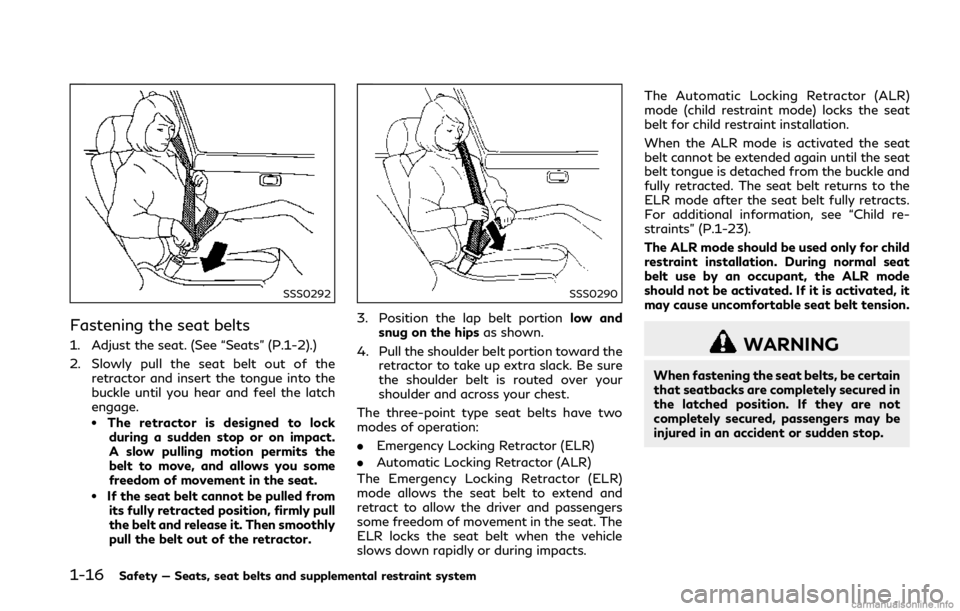
1-16Safety — Seats, seat belts and supplemental restraint system
SSS0292
Fastening the seat belts
1. Adjust the seat. (See “Seats” (P.1-2).)
2. Slowly pull the seat belt out of theretractor and insert the tongue into the
buckle until you hear and feel the latch
engage.
.The retractor is designed to lockduring a sudden stop or on impact.
A slow pulling motion permits the
belt to move, and allows you some
freedom of movement in the seat.
.If the seat belt cannot be pulled from its fully retracted position, firmly pull
the belt and release it. Then smoothly
pull the belt out of the retractor.
SSS0290
3. Position the lap belt portion low and
snug on the hips as shown.
4. Pull the shoulder belt portion toward the retractor to take up extra slack. Be sure
the shoulder belt is routed over your
shoulder and across your chest.
The three-point type seat belts have two
modes of operation:
. Emergency Locking Retractor (ELR)
. Automatic Locking Retractor (ALR)
The Emergency Locking Retractor (ELR)
mode allows the seat belt to extend and
retract to allow the driver and passengers
some freedom of movement in the seat. The
ELR locks the seat belt when the vehicle
slows down rapidly or during impacts. The Automatic Locking Retractor (ALR)
mode (child restraint mode) locks the seat
belt for child restraint installation.
When the ALR mode is activated the seat
belt cannot be extended again until the seat
belt tongue is detached from the buckle and
fully retracted. The seat belt returns to the
ELR mode after the seat belt fully retracts.
For additional information, see “Child re-
straints” (P.1-23).
The ALR mode should be used only for child
restraint installation. During normal seat
belt use by an occupant, the ALR mode
should not be activated. If it is activated, it
may cause uncomfortable seat belt tension.
WARNING
When fastening the seat belts, be certain
that seatbacks are completely secured in
the latched position. If they are not
completely secured, passengers may be
injured in an accident or sudden stop.
Page 37 of 458
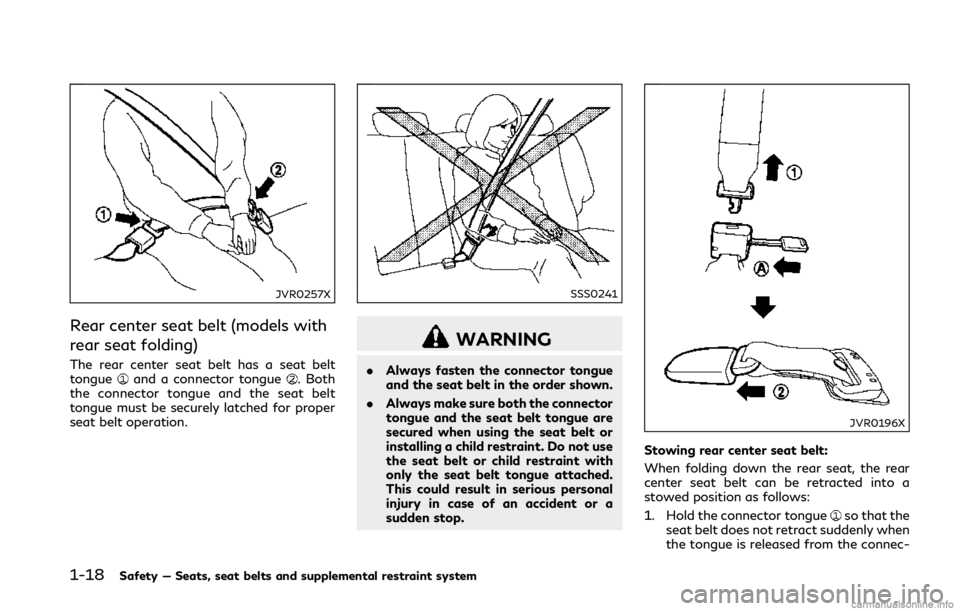
1-18Safety — Seats, seat belts and supplemental restraint system
JVR0257X
Rear center seat belt (models with
rear seat folding)
The rear center seat belt has a seat belt
tongueand a connector tongue. Both
the connector tongue and the seat belt
tongue must be securely latched for proper
seat belt operation.
SSS0241
WARNING
. Always fasten the connector tongue
and the seat belt in the order shown.
. Always make sure both the connector
tongue and the seat belt tongue are
secured when using the seat belt or
installing a child restraint. Do not use
the seat belt or child restraint with
only the seat belt tongue attached.
This could result in serious personal
injury in case of an accident or a
sudden stop.
JVR0196X
Stowing rear center seat belt:
When folding down the rear seat, the rear
center seat belt can be retracted into a
stowed position as follows:
1. Hold the connector tongue
so that the
seat belt does not retract suddenly when
the tongue is released from the connec-
Page 38 of 458
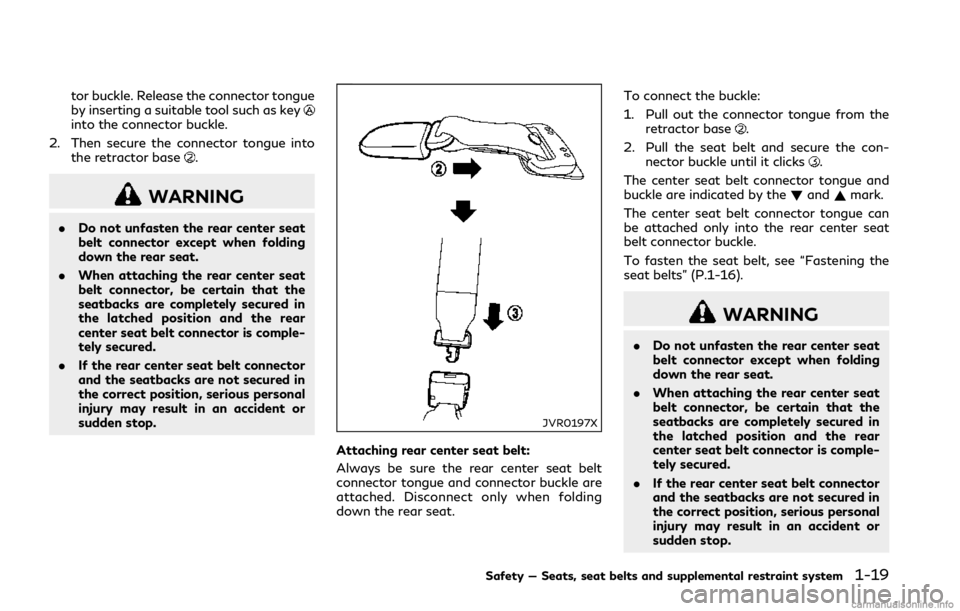
tor buckle. Release the connector tongue
by inserting a suitable tool such as key
into the connector buckle.
2. Then secure the connector tongue into the retractor base
.
WARNING
.Do not unfasten the rear center seat
belt connector except when folding
down the rear seat.
. When attaching the rear center seat
belt connector, be certain that the
seatbacks are completely secured in
the latched position and the rear
center seat belt connector is comple-
tely secured.
. If the rear center seat belt connector
and the seatbacks are not secured in
the correct position, serious personal
injury may result in an accident or
sudden stop.
JVR0197X
Attaching rear center seat belt:
Always be sure the rear center seat belt
connector tongue and connector buckle are
attached. Disconnect only when folding
down the rear seat. To connect the buckle:
1. Pull out the connector tongue from the
retractor base
.
2. Pull the seat belt and secure the con- nector buckle until it clicks
.
The center seat belt connector tongue and
buckle are indicated by the !and ~mark.
The center seat belt connector tongue can
be attached only into the rear center seat
belt connector buckle.
To fasten the seat belt, see “Fastening the
seat belts” (P.1-16).
WARNING
. Do not unfasten the rear center seat
belt connector except when folding
down the rear seat.
. When attaching the rear center seat
belt connector, be certain that the
seatbacks are completely secured in
the latched position and the rear
center seat belt connector is comple-
tely secured.
. If the rear center seat belt connector
and the seatbacks are not secured in
the correct position, serious personal
injury may result in an accident or
sudden stop.
Safety — Seats, seat belts and supplemental restraint system1-19
Page 41 of 458
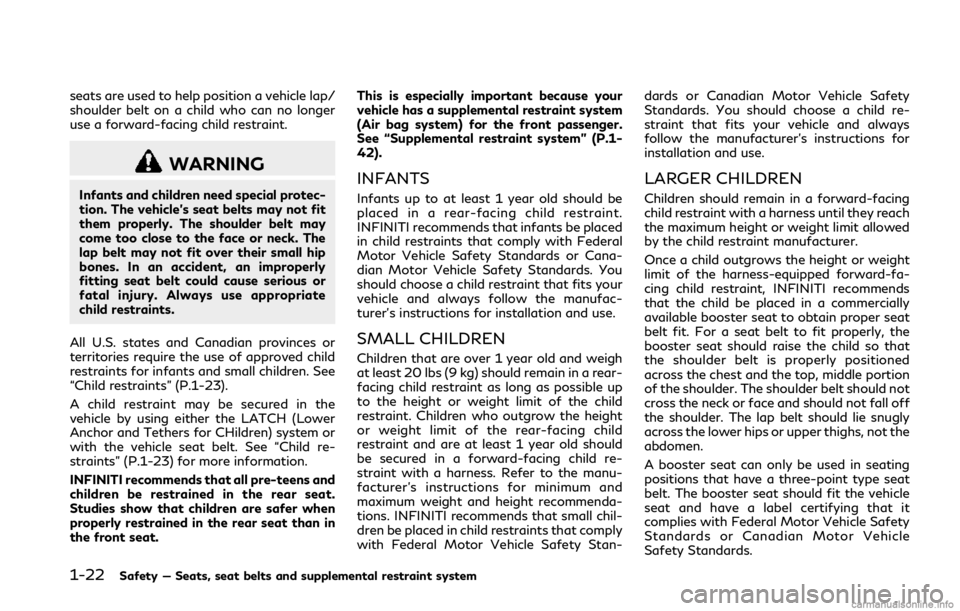
1-22Safety — Seats, seat belts and supplemental restraint system
seats are used to help position a vehicle lap/
shoulder belt on a child who can no longer
use a forward-facing child restraint.
WARNING
Infants and children need special protec-
tion. The vehicle’s seat belts may not fit
them properly. The shoulder belt may
come too close to the face or neck. The
lap belt may not fit over their small hip
bones. In an accident, an improperly
fitting seat belt could cause serious or
fatal injury. Always use appropriate
child restraints.
All U.S. states and Canadian provinces or
territories require the use of approved child
restraints for infants and small children. See
“Child restraints” (P.1-23).
A child restraint may be secured in the
vehicle by using either the LATCH (Lower
Anchor and Tethers for CHildren) system or
with the vehicle seat belt. See “Child re-
straints” (P.1-23) for more information.
INFINITI recommends that all pre-teens and
children be restrained in the rear seat.
Studies show that children are safer when
properly restrained in the rear seat than in
the front seat. This is especially important because your
vehicle has a supplemental restraint system
(Air bag system) for the front passenger.
See “Supplemental restraint system” (P.1-
42).INFANTS
Infants up to at least 1 year old should be
placed in a rear-facing child restraint.
INFINITI recommends that infants be placed
in child restraints that comply with Federal
Motor Vehicle Safety Standards or Cana-
dian Motor Vehicle Safety Standards. You
should choose a child restraint that fits your
vehicle and always follow the manufac-
turer’s instructions for installation and use.
SMALL CHILDREN
Children that are over 1 year old and weigh
at least 20 lbs (9 kg) should remain in a rear-
facing child restraint as long as possible up
to the height or weight limit of the child
restraint. Children who outgrow the height
or weight limit of the rear-facing child
restraint and are at least 1 year old should
be secured in a forward-facing child re-
straint with a harness. Refer to the manu-
facturer’s instructions for minimum and
maximum weight and height recommenda-
tions. INFINITI recommends that small chil-
dren be placed in child restraints that comply
with Federal Motor Vehicle Safety Stan-dards or Canadian Motor Vehicle Safety
Standards. You should choose a child re-
straint that fits your vehicle and always
follow the manufacturer’s instructions for
installation and use.
LARGER CHILDREN
Children should remain in a forward-facing
child restraint with a harness until they reach
the maximum height or weight limit allowed
by the child restraint manufacturer.
Once a child outgrows the height or weight
limit of the harness-equipped forward-fa-
cing child restraint, INFINITI recommends
that the child be placed in a commercially
available booster seat to obtain proper seat
belt fit. For a seat belt to fit properly, the
booster seat should raise the child so that
the shoulder belt is properly positioned
across the chest and the top, middle portion
of the shoulder. The shoulder belt should not
cross the neck or face and should not fall off
the shoulder. The lap belt should lie snugly
across the lower hips or upper thighs, not the
abdomen.
A booster seat can only be used in seating
positions that have a three-point type seat
belt. The booster seat should fit the vehicle
seat and have a label certifying that it
complies with Federal Motor Vehicle Safety
Standards or Canadian Motor Vehicle
Safety Standards.
Page 43 of 458
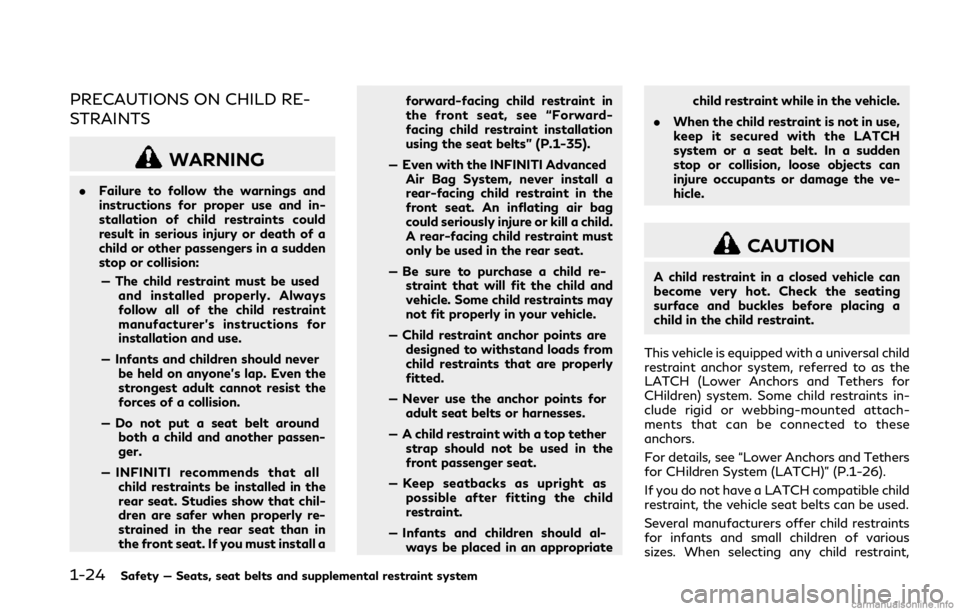
1-24Safety — Seats, seat belts and supplemental restraint system
PRECAUTIONS ON CHILD RE-
STRAINTS
WARNING
.Failure to follow the warnings and
instructions for proper use and in-
stallation of child restraints could
result in serious injury or death of a
child or other passengers in a sudden
stop or collision:
— The child restraint must be used and installed properly. Always
follow all of the child restraint
manufacturer’s instructions for
installation and use.
— Infants and children should never be held on anyone’s lap. Even the
strongest adult cannot resist the
forces of a collision.
— Do not put a seat belt around both a child and another passen-
ger.
— INFINITI recommends that all child restraints be installed in the
rear seat. Studies show that chil-
dren are safer when properly re-
strained in the rear seat than in
the front seat. If you must install a forward-facing child restraint in
the front seat, see “Forward-
facing child restraint installation
using the seat belts” (P.1-35).
— Even with the INFINITI Advanced Air Bag System, never install a
rear-facing child restraint in the
front seat. An inflating air bag
could seriously injure or kill a child.
A rear-facing child restraint must
only be used in the rear seat.
— Be sure to purchase a child re- straint that will fit the child and
vehicle. Some child restraints may
not fit properly in your vehicle.
— Child restraint anchor points are designed to withstand loads from
child restraints that are properly
fitted.
— Never use the anchor points for adult seat belts or harnesses.
— A child restraint with a top tether strap should not be used in the
front passenger seat.
— Keep seatbacks as upright as possible after fitting the child
restraint.
— Infants and children should al- ways be placed in an appropriate child restraint while in the vehicle.
. When the child restraint is not in use,
keep it secured with the LATCH
system or a seat belt. In a sudden
stop or collision, loose objects can
injure occupants or damage the ve-
hicle.
CAUTION
A child restraint in a closed vehicle can
become very hot. Check the seating
surface and buckles before placing a
child in the child restraint.
This vehicle is equipped with a universal child
restraint anchor system, referred to as the
LATCH (Lower Anchors and Tethers for
CHildren) system. Some child restraints in-
clude rigid or webbing-mounted attach-
ments that can be connected to these
anchors.
For details, see “Lower Anchors and Tethers
for CHildren System (LATCH)” (P.1-26).
If you do not have a LATCH compatible child
restraint, the vehicle seat belts can be used.
Several manufacturers offer child restraints
for infants and small children of various
sizes. When selecting any child restraint,
Page 44 of 458
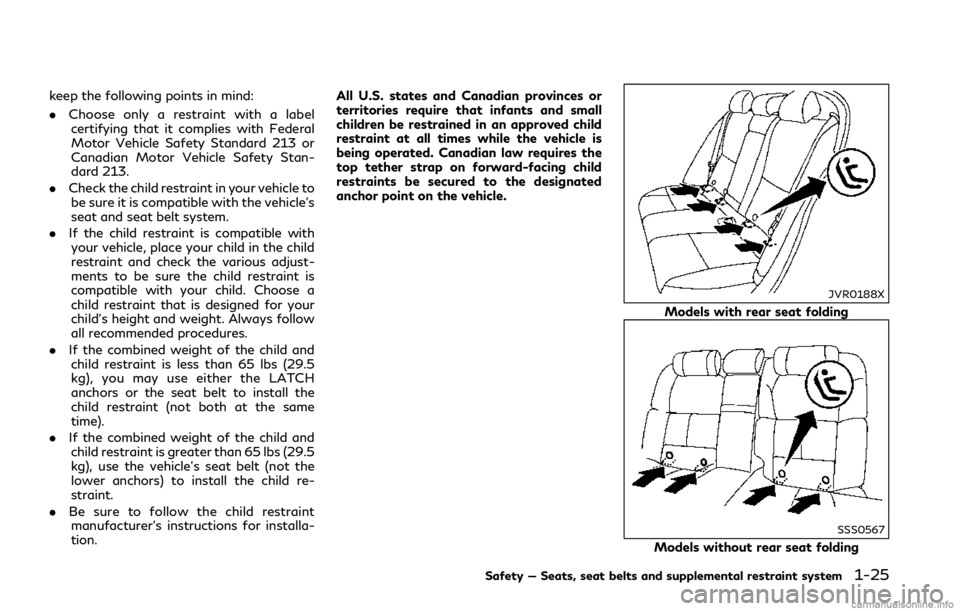
keep the following points in mind:
.Choose only a restraint with a label
certifying that it complies with Federal
Motor Vehicle Safety Standard 213 or
Canadian Motor Vehicle Safety Stan-
dard 213.
. Check the child restraint in your vehicle to
be sure it is compatible with the vehicle’s
seat and seat belt system.
. If the child restraint is compatible with
your vehicle, place your child in the child
restraint and check the various adjust-
ments to be sure the child restraint is
compatible with your child. Choose a
child restraint that is designed for your
child’s height and weight. Always follow
all recommended procedures.
. If the combined weight of the child and
child restraint is less than 65 lbs (29.5
kg), you may use either the LATCH
anchors or the seat belt to install the
child restraint (not both at the same
time).
. If the combined weight of the child and
child restraint is greater than 65 lbs (29.5
kg), use the vehicle’s seat belt (not the
lower anchors) to install the child re-
straint.
. Be sure to follow the child restraint
manufacturer’s instructions for installa-
tion. All U.S. states and Canadian provinces or
territories require that infants and small
children be restrained in an approved child
restraint at all times while the vehicle is
being operated. Canadian law requires the
top tether strap on forward-facing child
restraints be secured to the designated
anchor point on the vehicle.
JVR0188X
Models with rear seat folding
SSS0567
Models without rear seat folding
Safety — Seats, seat belts and supplemental restraint system1-25